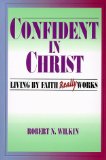Confident in Christ: Living by Faith Really Works.By Robert N. Wilkin. Irving, TX: Grace Evangelical Society, 1999. 287 + xii pp. Paper, $9.95.
Robert Wilkin is a man after my own heart. He has a passion to handle the Word of God accurately in order that he might stand approved after testing by God. In the spirit of 2 Tim 2:15 he has “created a sweat” in the pursuit of being found faithful to the meaning of the author. In the process he has done us all a real service by following careful hermeneutics in the development of word studies, grammatical relationships, and consideration of context, as well as the culture. He does not come to the text superimposing a creedal statement or a denominational agenda. He works hard at letting the text speak rather than speaking to the text. In so doing he has provided a gold mine of research in many passages that result in turning on all kinds of lights of clearer understanding.
Much of this clarity comes by being careful not to follow the common error of reducing the word “salvation” to justification. Recognizing that there are many things that one can be saved from, he will often raise the question “Saved from what?” Is the passage talking about physical deliverance from danger, disease, or death? Or, on the other hand, is it spiritual deliverance from the penalty of sin or from the power of sin? As a matter of fact, there is far more in Scripture about the latter than the former. Wilkin helps us to see that there is a sense in which the saved (i.e., justified) need to go on being saved (i.e., sanctified). If believers could simply get a handle on this truth, it would make a world of difference in communicating our Savior to a world that desperately needs to see Christ modeled today.
Another distinction that is carefully articulated is that of the gift of eternal life which can be received without cost by all who desire it, and the reward for faithfulness and endurance that comes to those who are willing to pay the price. Many today have been confused by those pastors and teachers who combine the two and present a “costly gift” theology that results in multitudes being in doubt and uncertainty with respect to their place in eternity.
Having said all of that, one might get the impression that this is a book so heavy with content that only the erudite scholar could profit from it. But that is not the case. Wilkin is a man of our culture who is able through relevant illustrations to bring the truth home to the layperson of the 21st century. Time and again the readers will find themselves saying “That really makes sense. Why haven’t I seen that?”
Now I hasten to add that Wilkin has not always had this clarity of theological understanding. Whereas his whole life seems to have been pursued with passion, many years of his youth were plagued with devastating legalism. He had devotion and dedication but he did not understand the unique. Some books are written in a matter of days. Others take years. Some take a lifetime. This one is somewhere between “years” and “lifetime.”
Nor is this work infallible, for there is only one of those. I have no doubt that a man like Wilkin, who in my opinion has the gift of knowledge, will continue to discover refinements even as he has with his view of the doctrine of repentance which is different today than when he finished an entire doctoral dissertation on the subject. The reader will find this more recent view among the several very helpful appendices. The work is divided into four major sections dealing with Saving Faith, Assurance, Eternal Security, and Perseverance. There is also a study guide that presents a list of questions to consider in pursuing each of the twenty chapters. Furthermore, the twenty-six pages of endnotes provide very helpful material for further study and comparison of views.
Finally, I would not be faithful to my task if I did not make a few suggestions. First, because the word “saved” covers a broad area of meanings, it would be helpful if, when we mean justified or regenerated, we would say so rather than making “saved” carry the whole burden of justification, sanctification, and glorification.
Second, I live for the day when speakers and writers will stop the common habit of making “literal” and “figurative” antithetical to each other (for example, see p. 191). We know better for we all know that literal interpretation includes both figurative and non-figurative language. A figure of speech is a perfectly acceptable vehicle for conveying a literal truth. We should never depart from the literal meaning for that is simply the single sense that the writer expressed.
Third, I would like to suggest to the author, with respect to the interpretation of John 15:6, that the setting is the spring of the year, and thus the statement about the burning of unproductive branches is irrelevant. Pruning takes place in the autumn—after the harvest. Furthermore, the identification of “they” in the verse may be advanced by noting that John has an inclusio that begins in 13:35 and ends with the same basic statement in 15:8. Perhaps the “they” in 15:6 is the “all” of 13:35 who fail to see the fruit (i.e., love) among Christians and thus discount us as worthy of consideration and cast us out.
I heartily commend this volume as a valuable resource volume that will be used for many years to come with great benefit. Keep it handy!
Earl D. Radmacher
President Emeritus
Western Conservative Baptist Theological Seminary
Portland, OR

